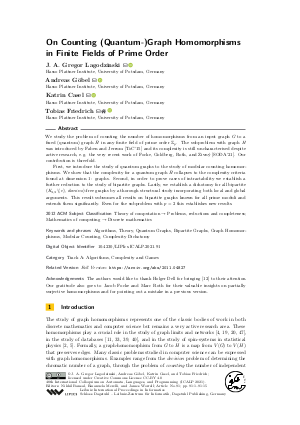@InProceedings{lagodzinski_et_al:LIPIcs.ICALP.2021.91,
author = {Lagodzinski, J. A. Gregor and G\"{o}bel, Andreas and Casel, Katrin and Friedrich, Tobias},
title = {{On Counting (Quantum-)Graph Homomorphisms in Finite Fields of Prime Order}},
booktitle = {48th International Colloquium on Automata, Languages, and Programming (ICALP 2021)},
pages = {91:1--91:15},
series = {Leibniz International Proceedings in Informatics (LIPIcs)},
ISBN = {978-3-95977-195-5},
ISSN = {1868-8969},
year = {2021},
volume = {198},
editor = {Bansal, Nikhil and Merelli, Emanuela and Worrell, James},
publisher = {Schloss Dagstuhl -- Leibniz-Zentrum f{\"u}r Informatik},
address = {Dagstuhl, Germany},
URL = {https://drops-dev.dagstuhl.de/entities/document/10.4230/LIPIcs.ICALP.2021.91},
URN = {urn:nbn:de:0030-drops-141608},
doi = {10.4230/LIPIcs.ICALP.2021.91},
annote = {Keywords: Algorithms, Theory, Quantum Graphs, Bipartite Graphs, Graph Homomorphisms, Modular Counting, Complexity Dichotomy}
}

 Creative Commons Attribution 4.0 International license
Creative Commons Attribution 4.0 International license


